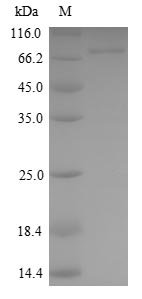Like all recombinant proteins, this Recombinant Human KEAP1 protein was encoded by recombinant DNA. The recombinant DNA was introduced to a plasmid in which the gene of KEAP1 was cloned downstream of a promoter region. When the plasmid was introduced to the cells of Yeast, the Yeast’s own protein synthesis pathways would then result in the expression of the KEAP1 protein. And the next step was protein purification. The purity of this recombinant protein is 90%+ determined by SDS-PAGE.
Kelch-like ECH-associated protein 1 (KEAP1) is a component of the Cullin 3 (CUL3)-based E3 ubiquitin ligase complex and controls the stability and accumulation of NRF2. The KEAP1 DC domain directly binds NRF2 through DLG and ETGE motifs within the N-terminal Neh2 domain of NRF2. KEAP1 is primarily localized to the perinuclear cytoplasm (22), loosely connected with the actin cytoskeleton, and serves to maintain the correct levels of NRF2. KEAP1 forms an E3 ubiquitin ligase complex with CUL3, acting as a substrate recognition/binding subunit. The KEAP1-based ubiquitin ligase complex ubiquitinates NRF2, subjecting NRF2 to rapid proteasomal degradation in the cytoplasm. This integration of the KEAP1-NRF2 system into multiple cellular signaling and metabolic pathways places NRF2 activation as a critical regulatory node in many disease phenotypes and suggests that the pharmaceutical modulation of NRF2’s cytoprotective activity will be beneficial for human health in a broad range of noncommunicable diseases.




